Last Updated on March 28, 2025 by Owen McGab Enaohwo
![What Is Standard Work? [How to Apply It in Your Business]](https://www.sweetprocess.com/wp-content/uploads/2025/01/standard-work.png)
In 1986, the NASA Challenger disaster shook the world to its core. Just 73 seconds after takeoff, the space shuttle exploded, killing all seven crew members.
The cause? A failure in the O-rings that should’ve sealed the rocket boosters. Engineers had raised concerns, but there was no clear, standardized process for evaluating and acting on the risks. This tragedy shows what can happen when unclear processes or inconsistencies slip through the cracks.
Standard work is how businesses avoid those kinds of mistakes.
It’s creating simple, step-by-step instructions for tasks so they’re done right every time.
Before we dive into this in-depth article, here’s a quick heads-up about SweetProcess. If you like getting things done the right way every time and want to streamline your standard work process, SweetProcess is the perfect platform for you. Try our 14-day free trial and watch how it transforms your workflow!
What You’ll Learn In This Guide:
Benefits of Standard Work in an Organization
How to Apply Standardized Work in Your Organization
How to Document Standard Work Using SweetProcess
Alternative Forms of Standard Work
What Should Not Be Standardized?
Who Benefits from Standardized Work?
Enhance Your Company’s Standard Work Documentation Using SweetProcess
What Is Standard Work?
Standard work is a simple way to document the most efficient method for completing a task so everyone knows exactly what to do. Instead of guessing or figuring things out on the fly, standard work gives you a step-by-step process to follow.
And no, this isn’t about controlling how people work—it’s about building consistency and saving time.
Benefits of Standard Work in an Organization
Streamlines Problem-Solving

Problems at work are as predictable as rainy days. But figuring out what went wrong can sometimes feel like trying to find a lost sock in a laundry basket.
When teams follow a consistent, established process, they create a reliable blueprint for what should happen. This approach makes it easy to pinpoint where things strayed off course.
This structured approach speeds up problem-solving and minimizes the trial-and-error headache.
And in some industries, having a standard method saves time and makes the difference between success and disaster.
Lowers Operational Costs

Process clarity allows teams to spot inefficiencies and bottlenecks, ensuring everything flows smoothly.
Defining the minimal work needed to keep things moving significantly reduces operational costs and improves productivity for organizations and businesses.
Makes the Improvement Easier and Faster

You know how messy it gets if you’ve ever tried to improve something without a clear plan.
Clear steps and guidelines assist teams in making improvements more easily and faster.
Instead of wasting time figuring out what to do next, teams can speed things up by following a proven method and achieving their desired results in less time.
Increases Agility and Scale Faster
Imagine having a set of tried-and-tested procedures everyone follows, no matter how much your company grows.
With these systems, teams avoid constantly reinventing the wheel or wasting time explaining the basics to new hires. Instead, you’re empowering your team to hit the ground running.
The best part? These systems free you up to focus on the big stuff—the things that help your business grow.
As you refine your processes over time, you’ll see even more improvements, allowing your company to scale without losing vital consistency.
Increases Customer Satisfaction

Standardized processes ensure that teams deliver products and services more consistently, which is precisely what customers want.
Standardized work ensures everyone follows the same guidelines, leading to higher and more predictable quality.
As a result, your team delivers exactly what customers expect every time.
Reduces Defects and Process Variation
Setting clear, simple instructions for everyone to follow reduces mistakes and inconsistencies.
When employees follow straightforward guides, they easily spot mistakes and adjust as needed.
Promotes Innovation
For continuous improvement to work, employees must feel they have the right space to speak up.
Managers must listen to employees’ ideas, evaluate them, and act on them. Standard work paves the way for setting a clear structure for sharing and reviewing feedback.
Elements of Standard Work
Takt Time
Things feel smooth if you’re playing a song and everyone’s dancing to the beat. But if you speed that same song up or slow it down, it throws off the entire flow of the audience.
Takt time is the same for production.
It’s not about rushing; it’s about hitting that sweet spot where everything runs efficiently without burning out or wasting resources.
You can calculate takt time by dividing the total available production time by the required units. This keeps everyone in sync with customer demand so you’re not working too fast or too slow.
Work Sequence
Work sequence following a specific order to stay organized and finish on time. And since time is limited (this is where takt time comes in), sticking to the steps ensures everything flows smoothly.
To make it easier, teams often create a standard work chart like a cheat sheet.
Want to change a car tire? The chart might lay it out like this:
- Step-by-step instructions: Loosen the lug nuts, jack up the car, remove the tire, put on the spare, tighten the lug nuts—you get the idea.
- Safety tips: Ensure the car is on a flat surface and the parking brake is on.
- Diagrams: A visual of where to place the jack or which way to turn the wrench.
Standard Inventory
Carrying too much inventory is costly and inefficient. That’s why businesses focus on keeping only the minimum amount of raw materials or parts needed to meet production needs.
Excess inventory ties up valuable resources and drives up costs.
Effective management systems are designed to help businesses find the right balance, reducing waste and improving overall efficiency.
How to Apply Standardized Work in Your Organization
Collect and Analyze Data on Your Current Operations

Establish a clear work sequence and calculate your takt time to optimize your operations.
Modern manufacturers use IoT-connected tools with cloud computing to replace manual tracking and automatically gather key data.
This data includes metrics like cycle time (how long it takes to complete an entire product) and step time (how long it takes for each operator to complete a step in the process).
Manufacturers continuously record these numbers to give managers real-time insight into factory floor operations.
This constant flow of data provides unparalleled visibility, allowing for quick adjustments when something isn’t working as it should.
Notice Variation and Issues

There’s rarely one way to complete a task. But there’s always the best way—using the least amount of materials, machinery, and manpower while delivering the best results.
To find that “best way,” take a step back and dive into the data you’ve been collecting.
You can use this process to spot subtle differences that often go unnoticed.
For example, you might notice some workers, even though they’re doing the same job, produce very different outcomes. This could be due to technique, experience, or external factors like tools or environment.
Next, look at your takt time. If someone consistently takes longer than expected, that’s a sign that something’s off. Maybe their process needs tweaking, or perhaps the task could be simplified or streamlined. Could two tasks be merged to save time? You’ll often find opportunities for efficiency right there.
Finally, always keep an eye out for safety or quality issues. Sometimes, the most glaring problems lie beneath the surface. A recurring error in a specific area or unsafe practices could lead to bigger risks down the road.
Find the Most Efficient Way to Run Your Operation
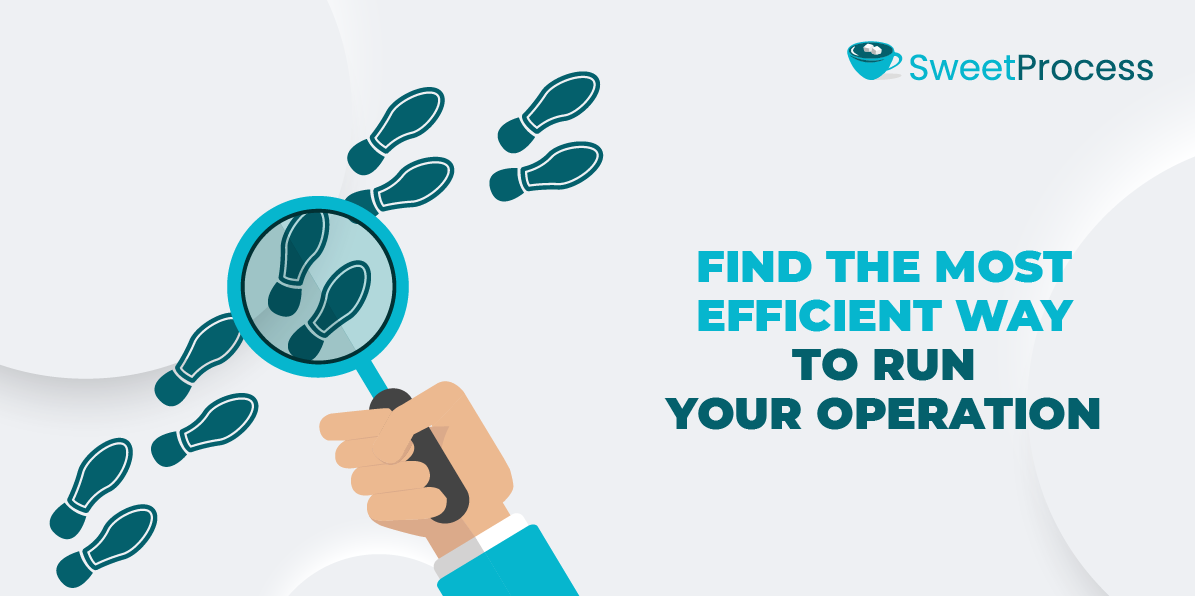
Running operations is simple. You just need to identify where performance is lagging and make it better.
By using lean methods like value stream mapping, you’re simply asking, “Where are the detours, and how can I cut them out?”
For instance, if a process has extra steps that don’t add any real value, get rid of them. Think of poka-yoke (a Japanese term meaning “mistake-proofing”) as your safety net. It’s like putting up signs that say, “Hey, don’t forget to double check!” so you don’t make mistakes.
Document Everything
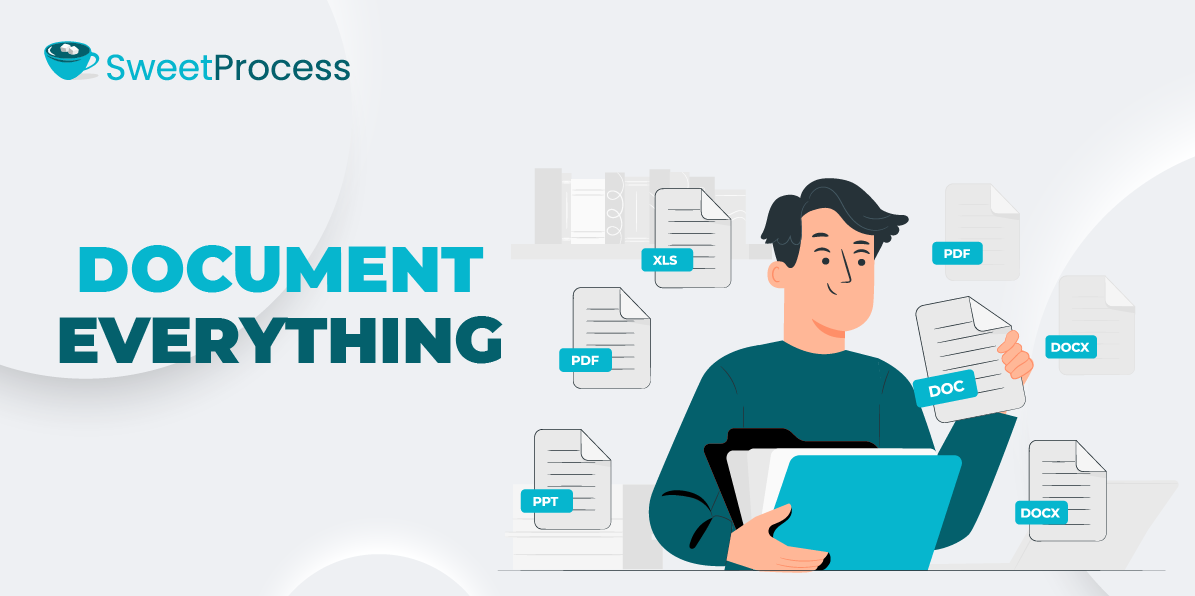
Three words: Digital. Work. Instructions.
Manufacturing apps create these instructions to make them interactive and easy to follow.
They guide workers through each step of a task, ensuring everything is done according to the most up-to-date best practices.
Unlike paper manuals or static documents, DWIs update instantly with just a few clicks to stay in sync with procedural changes.
Adapt Your Training Programs
Why is this crucial? Ensuring your team is on the same page and up to speed with the latest standard procedures is non-negotiable, especially for new hires.
To do this, rethink your training approach. Build it around the standardized work processes that guide your company’s operations. That way, no matter who walks through the door, they’ll have a solid foundation to build.
Now, let’s make this process even smoother. Why not go digital instead of relying on outdated manuals or long classroom sessions?
SweetProcess lets you create interactive multimedia training modules and update them easily. Videos, images, and step-by-step guides will let your employees, new or old, self-navigate through the most recent procedures.
Continuously Improve the Standard

Do you know why Tony Stark is arguably the best MCU character? Well, aside from his genius intellect, unmatched wit, and iconic Iron Man suits, there is one thing that makes him truly special.
“He learns from his mistakes” (a saying that is slowly becoming a longstanding phrase among Marvel fans).
Many people think that setting a standard means the work is done.
But that’s only the start. Standardized work isn’t static; it’s meant to evolve.
The true value lies in the relentless pursuit of improvement, improving the process with each passing day. Once you’ve standardized something, don’t settle—challenge it, refine it, and make it even more efficient.
If you were Tony Stark, how would you improve your standard over time?
When you encounter problems, ask why they happened instead of just correcting them. Use this as an opportunity to dig deeper, identify the root cause, and apply lean process improvement techniques to optimize workflow.
Once the issue is understood, it’s time to rewrite the standard to prevent similar problems in the future. This creates a loop of improvement—new standards replace old ones, and each iteration brings you closer to a more efficient, error-free process.
How to Document Standard Work Using SweetProcess
Document Your Company’s SOP
Start by listing your team’s tasks often, then break them into simple steps. SweetProcess organizes these steps so everyone can easily access and follow them. Here’s how you can create a step-by-step guide:
- Go to your SweetProcess dashboard and click on “More” (it’s a drop-down menu). Then proceed to click on “Procedures.”
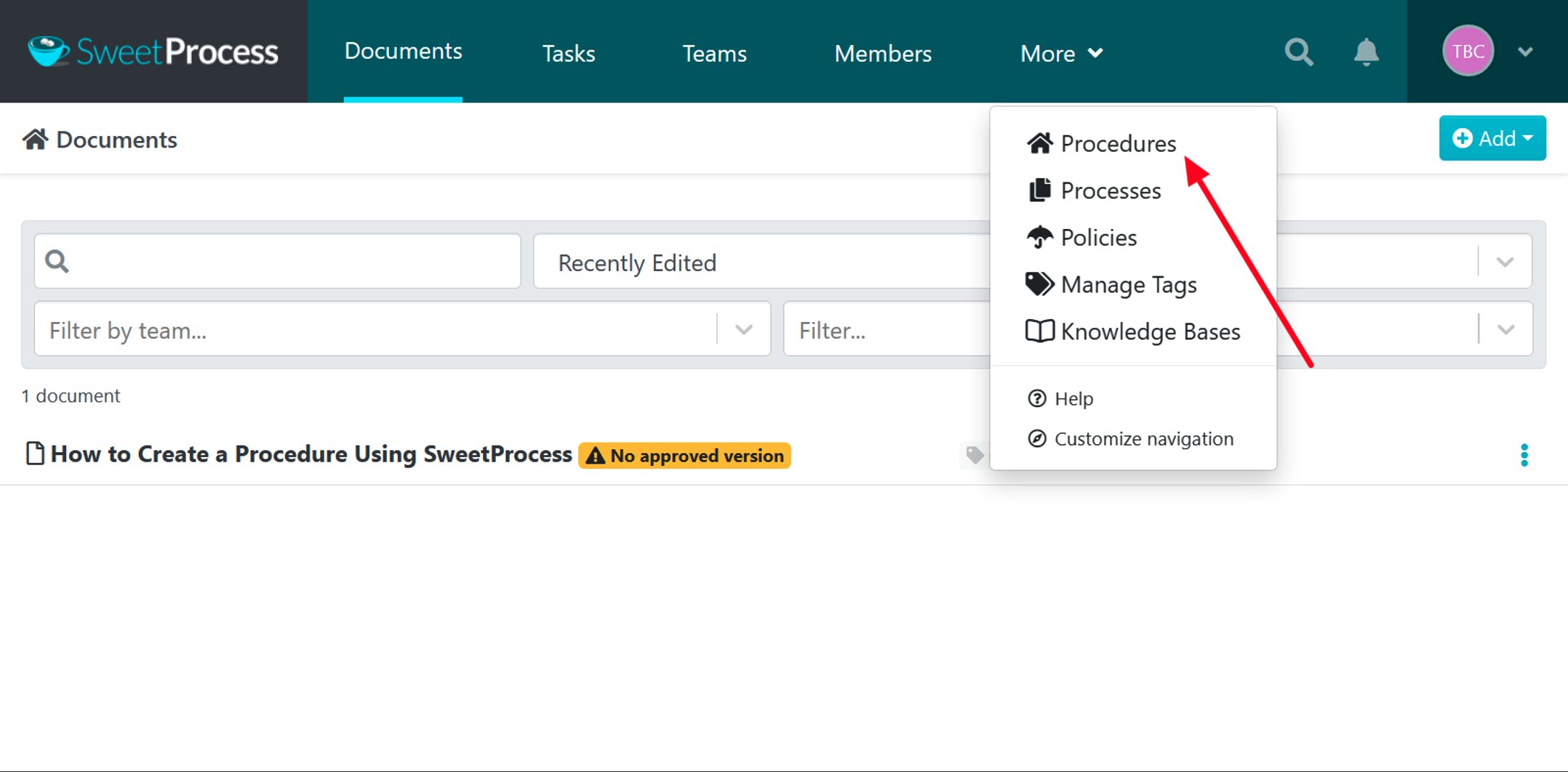
- On the new page, there’s a “Create Procedure” button on the top-right section of the page. Click on that and move to the next step.

- Here, you need to insert a title for your procedure. Quick note: SweetProcess has a pretty cool AI feature, “Write with Sweet AI,” that generates a Procedure based on your title.
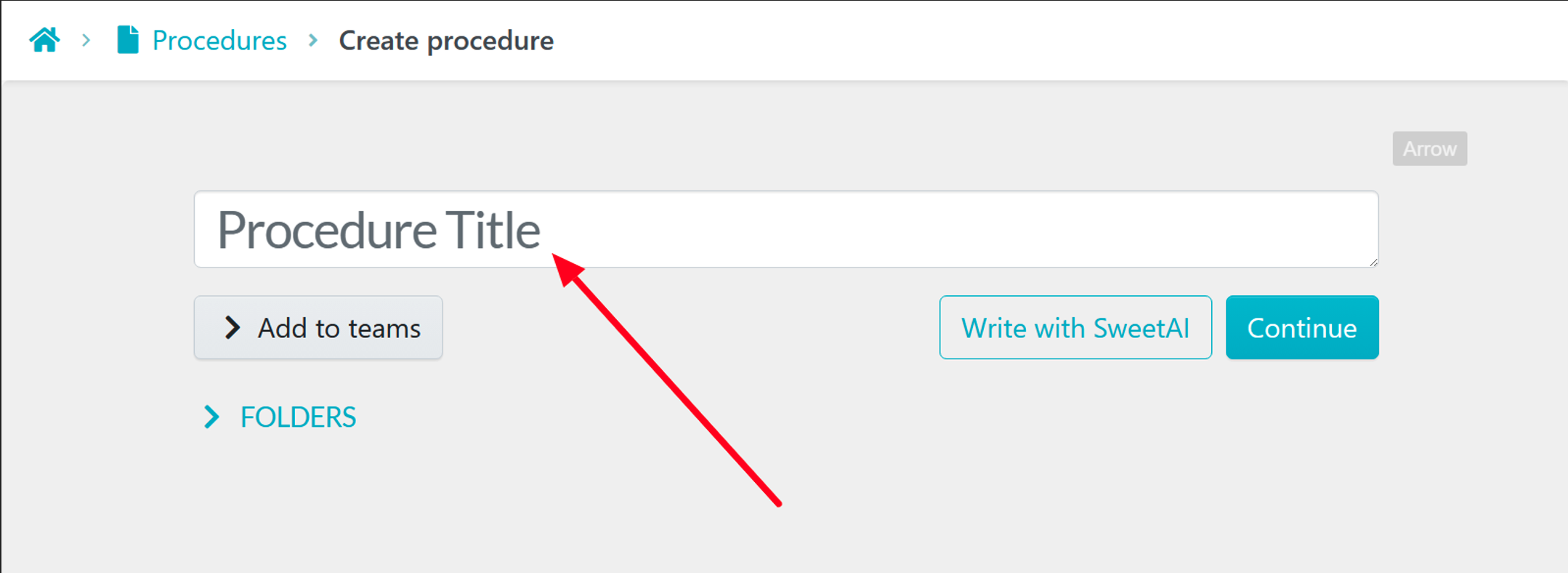
- You can also simultaneously add the procedure to a team or multiple teams in your company.
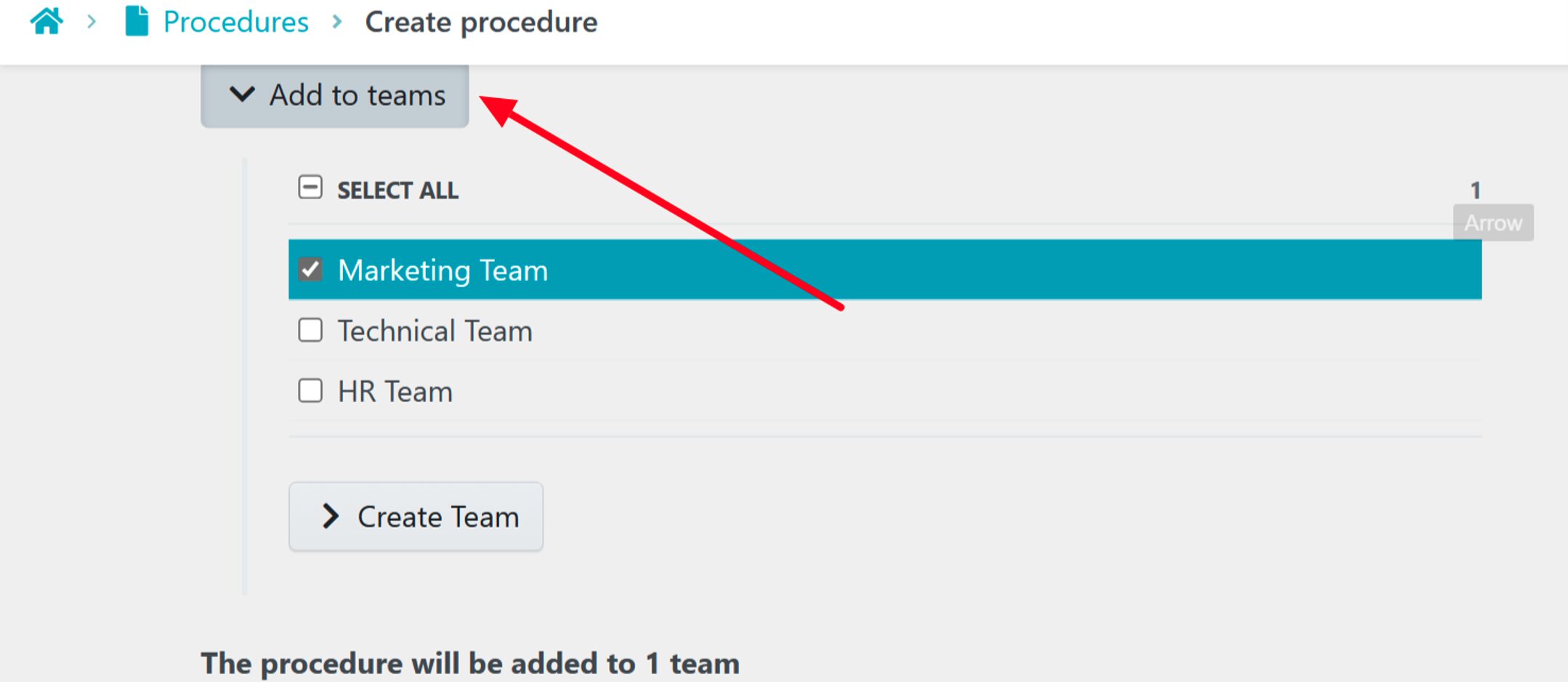
- To do this, click on the checkboxes of any of the team(s) in question. Next, click on “Continue.”

- Please note a few things on this editing page. First, you can add a procedure description by clicking on the title.
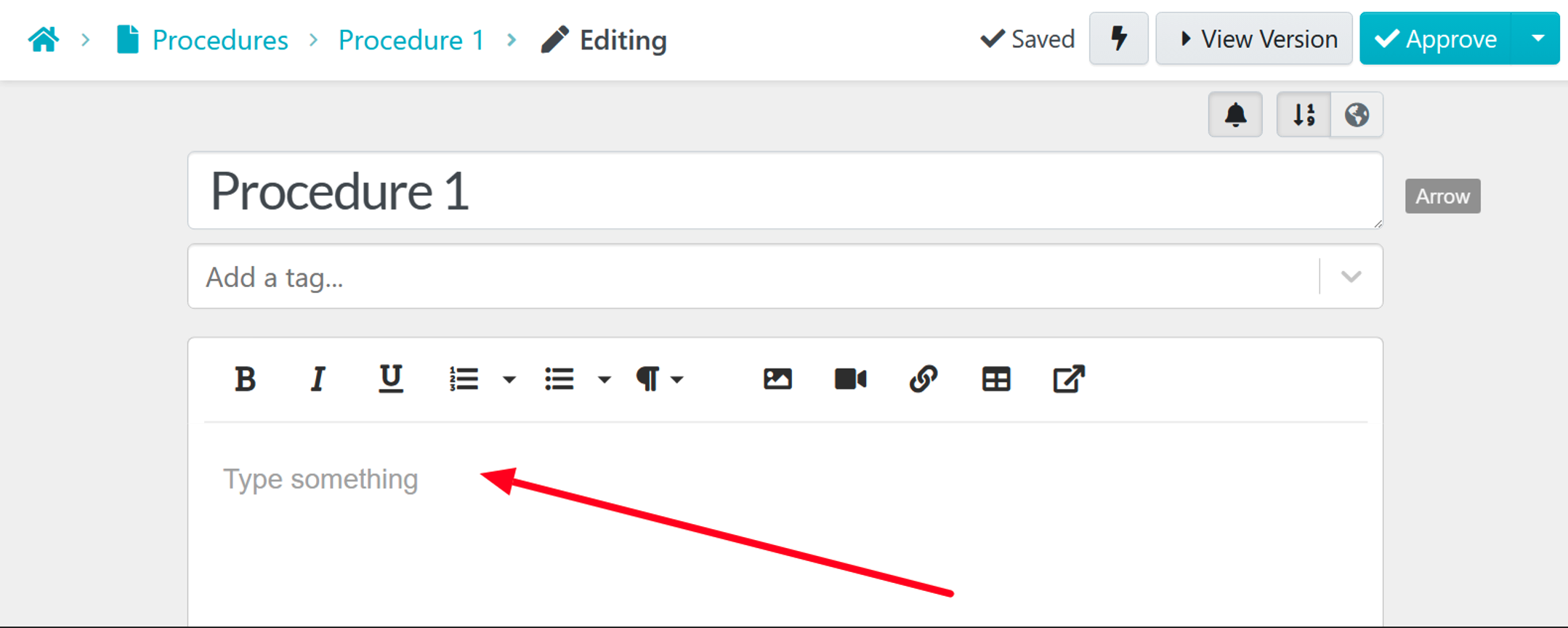
- You can also add a step to your procedure. Scroll to the bottom of the page and you’ll see a button that does just that.

- You can add a step by clicking the “Step” button. Then, give it a title and description.
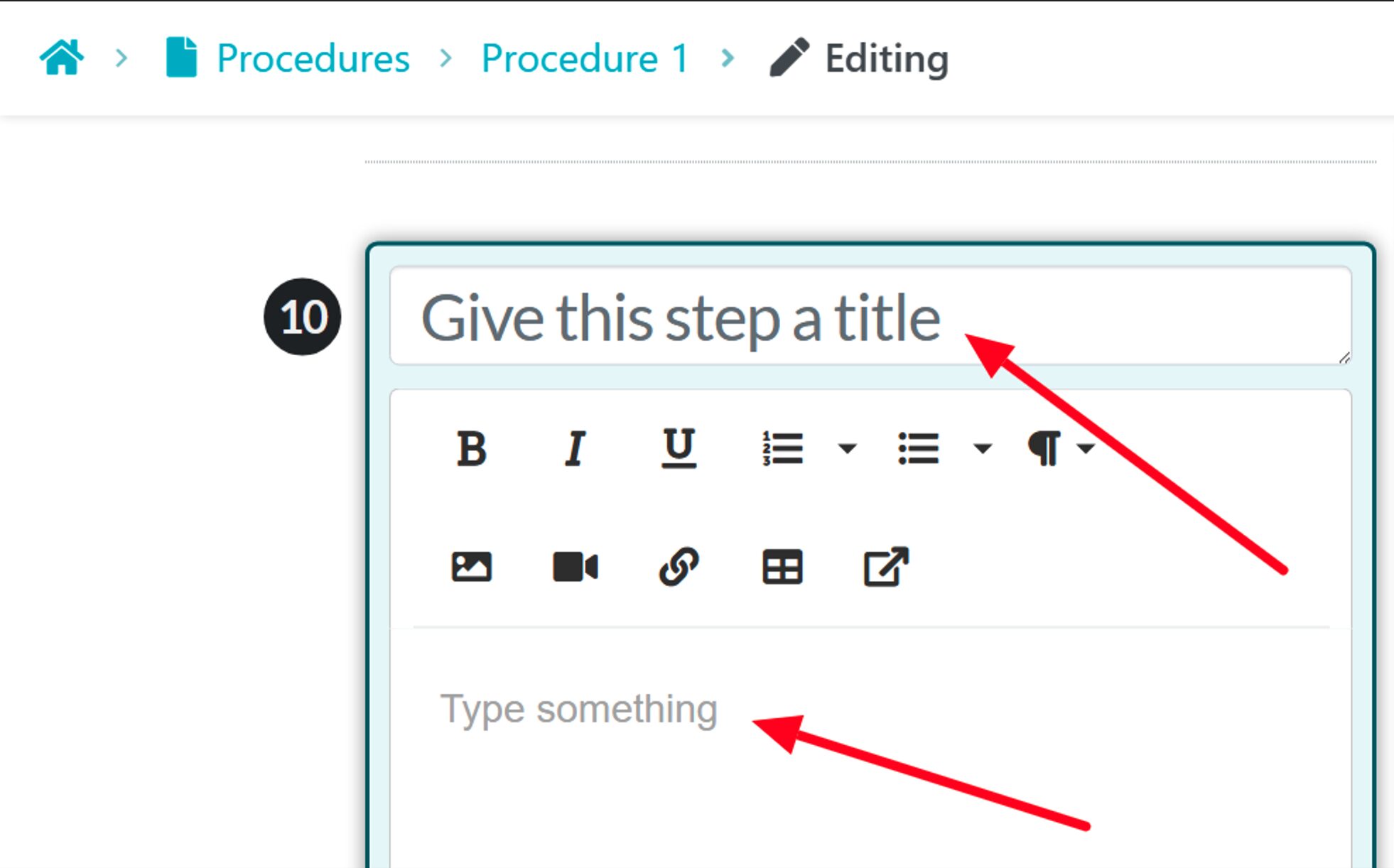
- You can attach files (images, documents, and even embedded videos) depending on your procedure. Once you’re done attaching your file, click on the “Finished editing” button to save the step.
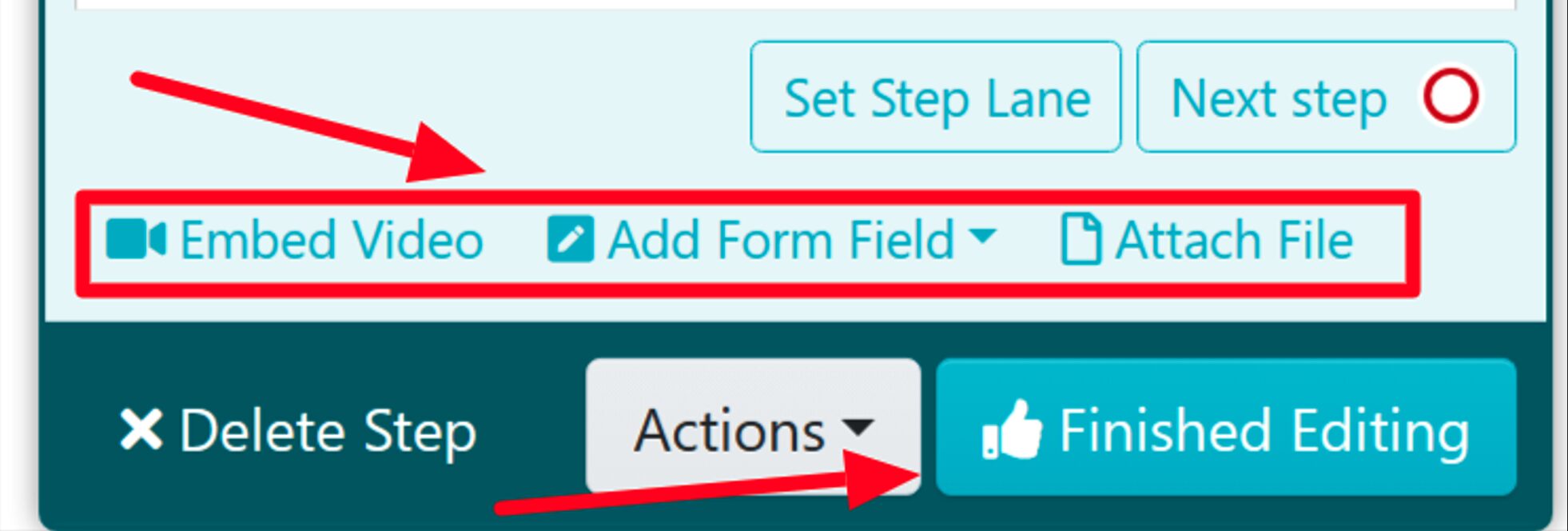
- You can repeat the steps above to add others until your procedure is complete.
- All that’s left is to approve the procedure. To do that, click on the “Approve” button at the page’s top right-hand corner.

Heads up: If you can’t approve the procedure, another team member may need to handle the approval. You can request approval using the provided button.

- Upon approval, you will be notified that your version is live.

Congratulations, you’ve uploaded your first procedure! Now, that wasn’t so hard, was it?
We’ve outlined these steps to make your journey with SweetProcess a walk in the park!
Manage Your SOP in One Place
After creating an SOP for your team, you can always update it. Simply go to your dashboard to find all the procedures listed.
Click on the procedure you wish to edit. The three-dot icon beside each procedure displays a menu with options depending on your goal.
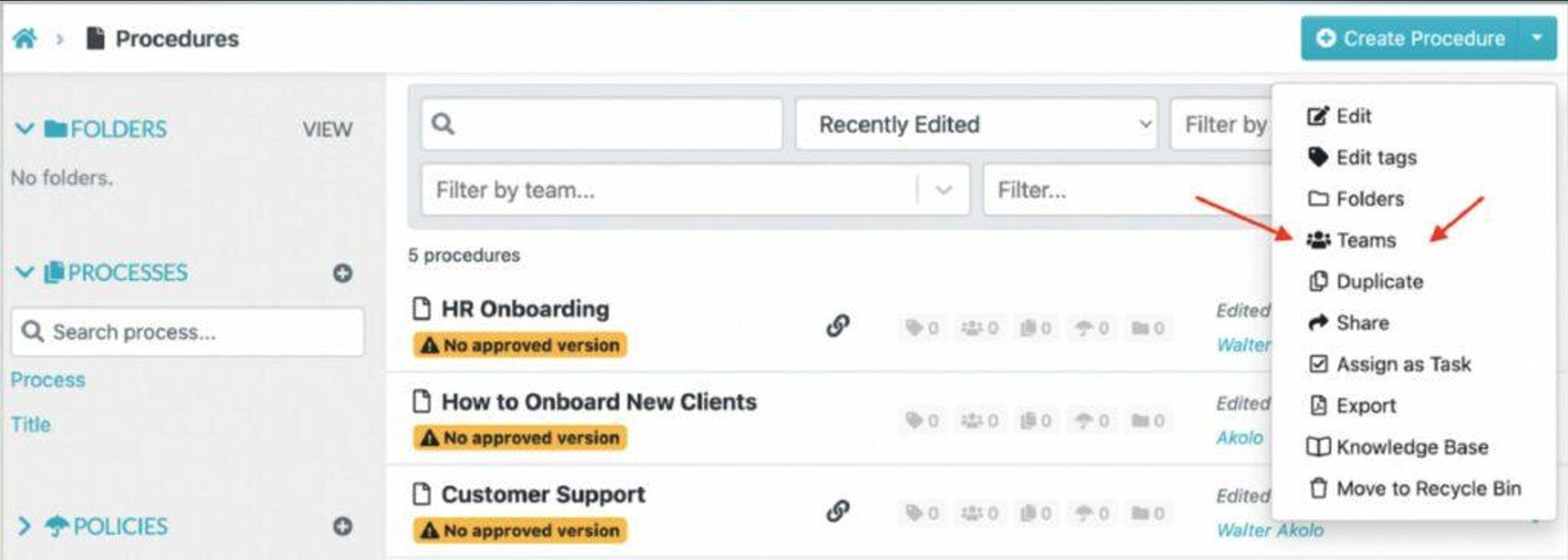
Assign Tasks and Collaborate With Team Members
SweetProcess also makes it possible for you to assign tasks to employees. Here’s how:
- Do you see that icon of three vertical dots? Click on it. It’s a drop-down menu.

- Click on “Assign as Task” when that menu pops up.
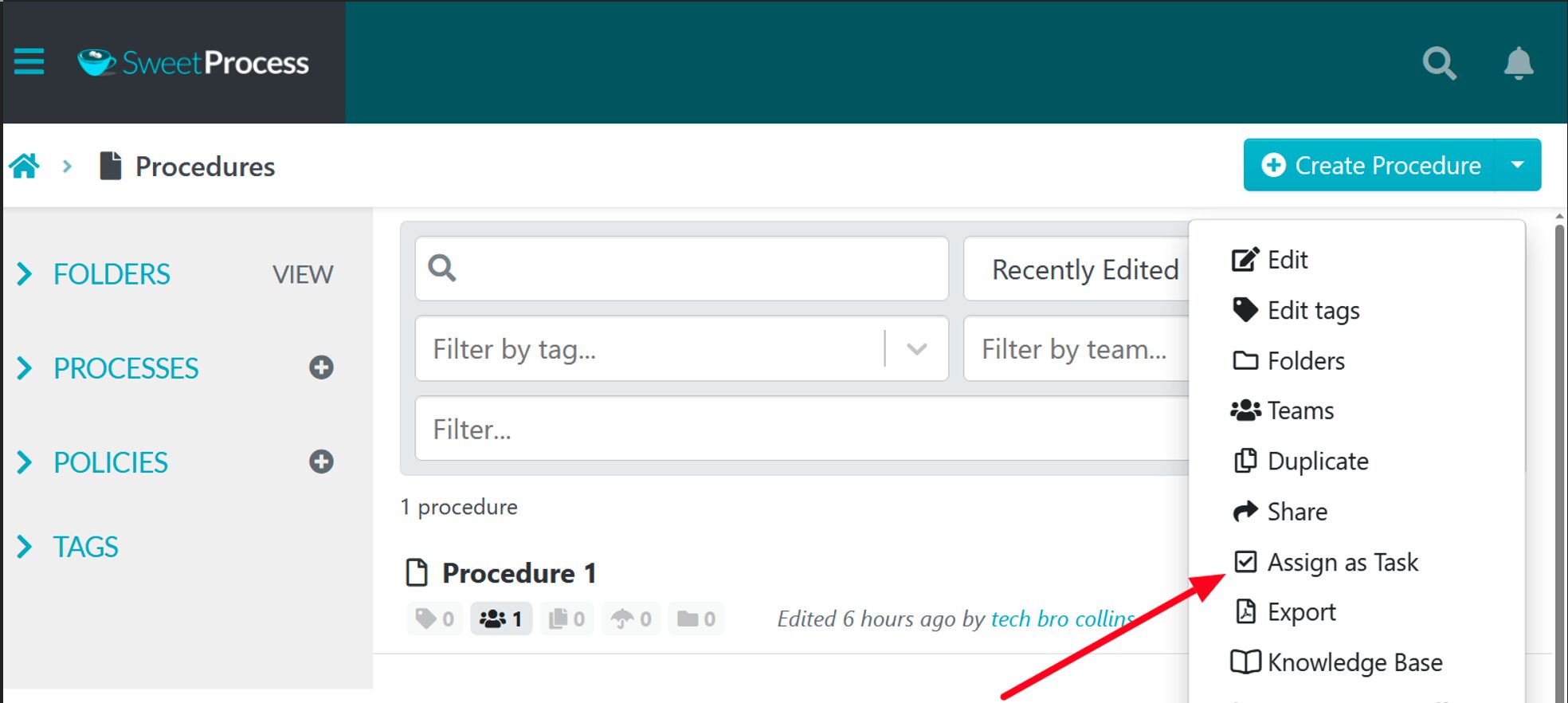
- Note: There’s also another way to assign a task in SweetProcess. To do that, open the procedure. Next, click on the “Actions” menu.
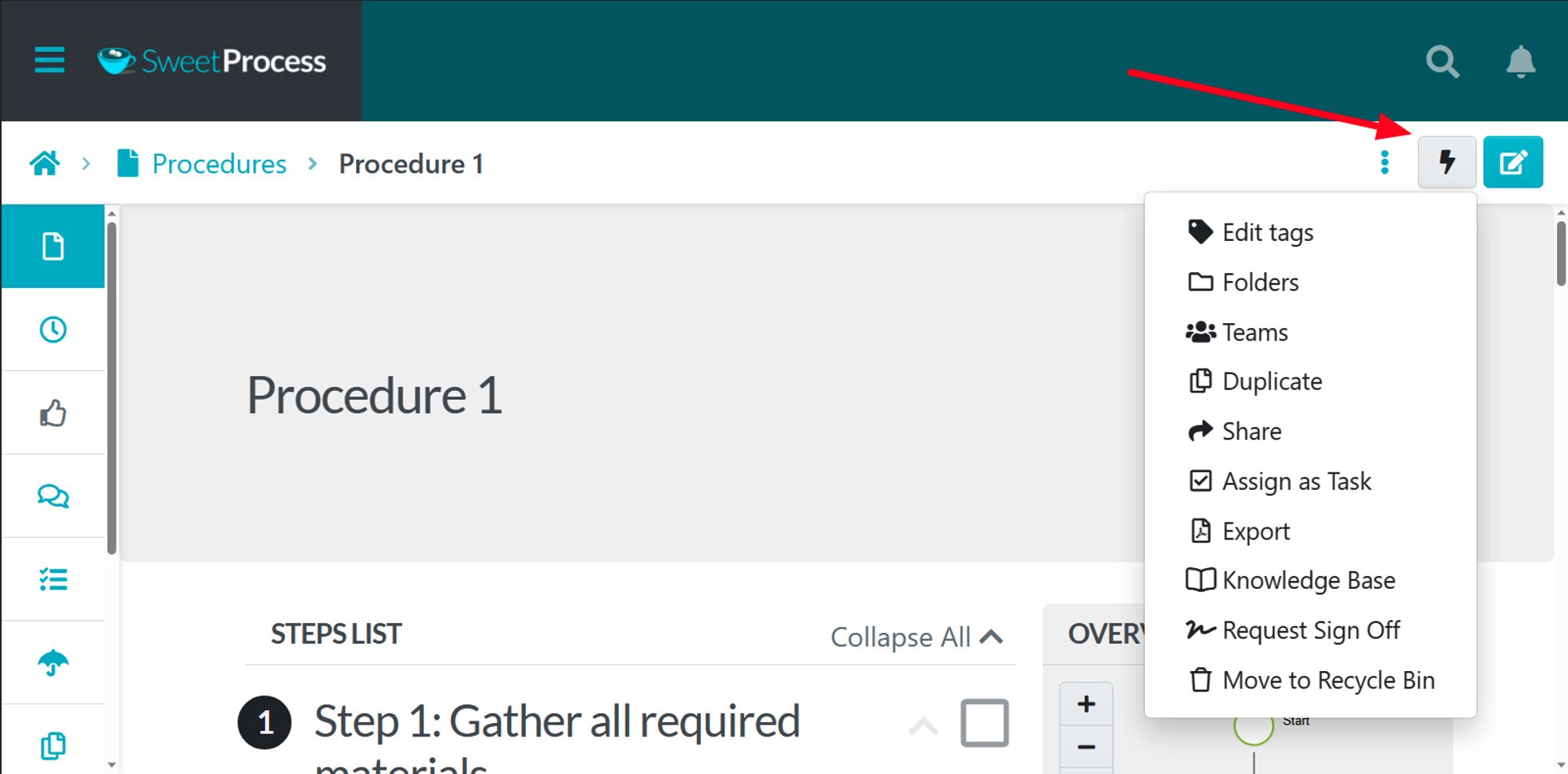
- You can assign a single task to the entire team or divide the work by assigning specific tasks to individual team members.
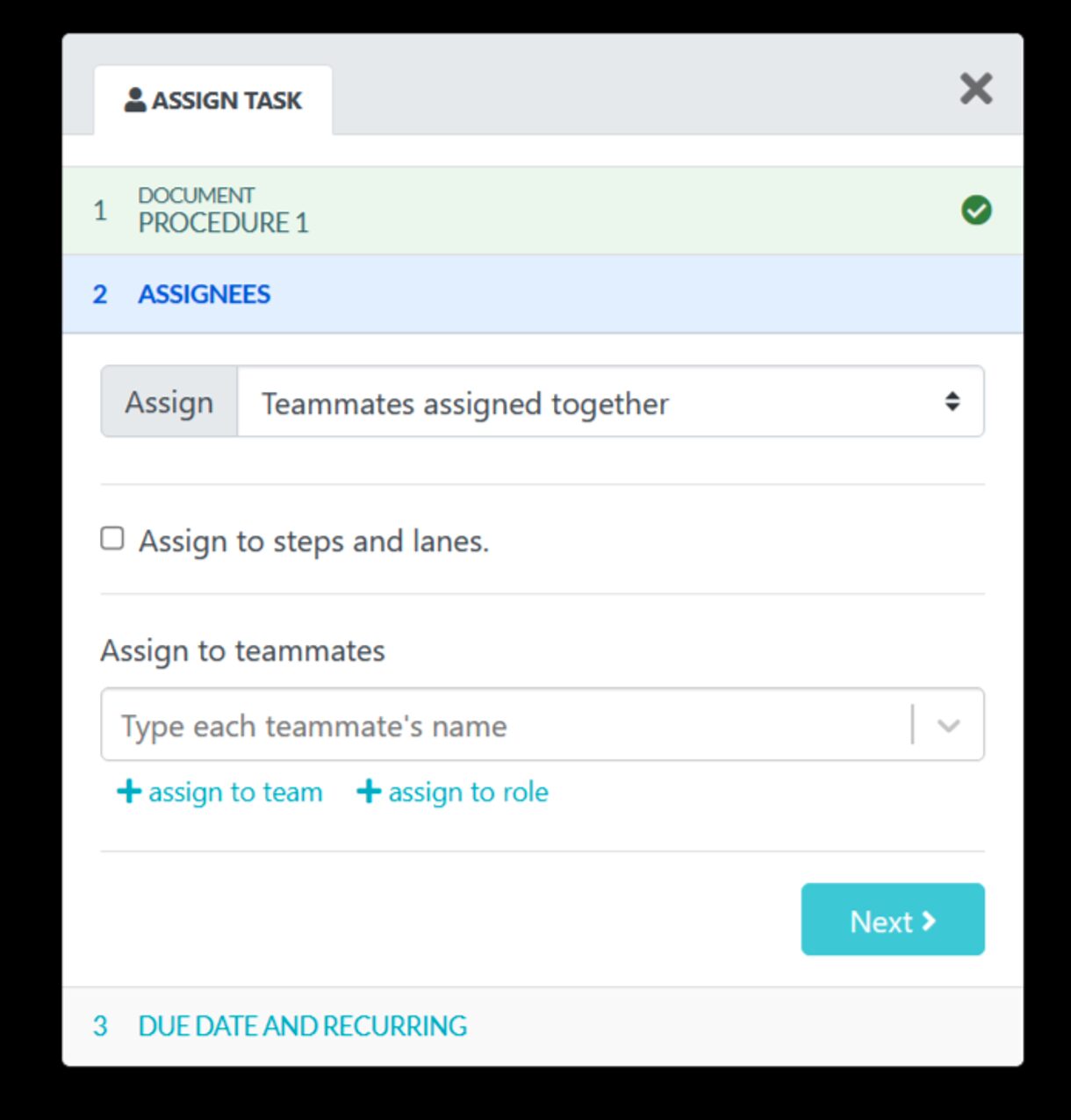
- What’s left is to fill in the remaining details on the form. The task is set to “Once Only” if you want your employee or team to complete the task a single time.
- If you want something different, like daily, weekly, monthly, or even yearly tasks, click on the “Repeat” drop-down menu and switch from “Once Only” to your preferred choice.
- Once assigned, SweetProcess notifies the employee or team that they have new tasks to complete. They also get reminder emails on the start and final days of the tasks (and another when the team manager marks their task complete).
We hope these guides assist you on your journey with SweetProcess. If you’re still having doubts about what we can do for your company, we’ve had many success stories from our existing clients.
Here’s how SweetProcess can be a game changer for your growing enterprise:
How Brooks Law Group Streamlined Operations With SweetProcess

Brooks Law Group specializes in personal injury cases and advocates for accident victims. With a deep understanding of legal complexities and empathy for their clients, the firm’s 31 employees across Lakeland, Winter Haven, and Tampa, Florida, are dedicated to justice.
Laura Johnson, administrator/HR at Brooks Law Group, knew the firm’s processes needed a significant overhaul. Serving injured and disabled clients required efficiency, yet their manual systems couldn’t support independent work or streamlined operations.
SweetProcess transformed its workflow, enabling autonomy and productivity. Through this shift, Brooks Law Group achieved remarkable efficiency.
The Challenge
Despite having documented processes, employees often bypassed them, relying on Laura for guidance. This dependency stalled progress and made the firm vulnerable to operational hiccups when Laura wasn’t available. The inefficiency was clear, and the firm needed a system enabling employee self-reliance.
The Solution: SweetProcess
Laura and a managing partner chose SweetProcess after a convincing demo showcased its ability to simplify and streamline operations. Implementing the software was seamless, and its benefits were evident.
These are the key benefits they get from using SweetProcess:
- Simplified process documentation
- Standardized operations
- Independent learning and training
- Uninterrupted workflow
Migrating to SweetProcess was straightforward. Existing processes were transferred into the platform and refined for clarity and a dedicated employee organized the content, followed by staff training to ensure everyone could use the system effectively.
As a result, Brooks Law Group now enjoys:
- Enhanced operational efficiency
- Empowered employees who work independently
- A resilient workflow that mitigates disruptions
Laura sums it up best:
“SweetProcess has liberated me as a manager and empowered our employees to perform without constant supervision.”
Switching to SweetProcess didn’t just improve systems; it transformed how Brooks Law Group operates, allowing them to focus on what matters most: serving their clients.
How Zen Media Streamlined Operations With SweetProcess

Zen Media, a Dallas-based PR firm, has been a powerhouse in the tech niche since its inception in 2009. Known for turning brand milestones into viral moments, the agency serves B2B and B2C clients worldwide. Despite its success, the agency struggled with disorganized workflows and knowledge silos. Employees relied on inconsistent, self-made processes, making scalability and team synergy a challenge.
When Stephanie Chavez returned as chief marketing officer, she made it her mission to fix this.
Though Zen Media delivered exceptional results, its internal processes were disorganized. There was no central knowledge base, leaving teams dependent on tribal knowledge. This created roadblocks when key employees were unavailable.
Stephanie identified that operational clarity and consistency were essential to scale the agency.
The question was: How?
The Solution
Stephanie discovered SweetProcess during a marketing seminar. Intrigued by its potential, she tested it—and it exceeded her expectations. SweetProcess became the backbone of Zen Media’s new operational excellence.
1. Seamless Onboarding
SweetProcess provided clear SOPs for new hires, reducing onboarding time and stress.
“I send them links to SweetProcess, and that’s all they need to get started!”
2. Consistent Quality Control
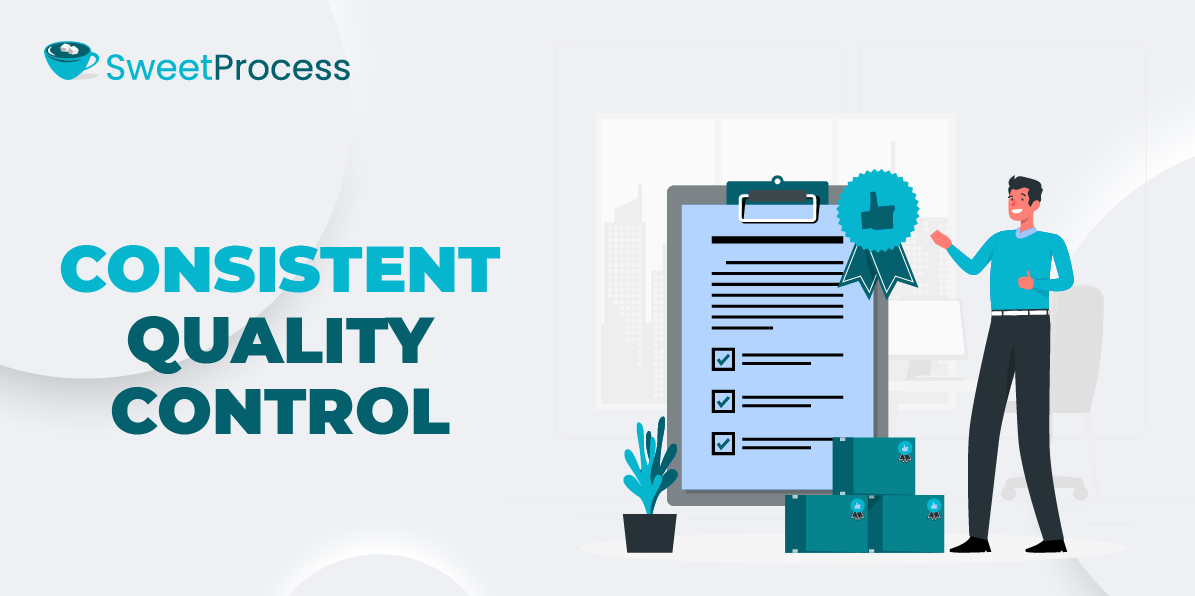
Uniformity was key. SweetProcess ensured that all team members followed the same procedures, leading to consistent and predictable results.
“Think McDonald’s: Consistency is crucial to scale. SweetProcess gave us that edge.”
3. Centralized Knowledge Base
Employees no longer relied on tribal knowledge. Tasks could seamlessly shift if someone was unavailable.
“Now, if Brandy is out, Natalie can pick up the slack without any delays.”
Results
SweetProcess brought clarity and efficiency to Zen Media, enabling:
- Faster onboarding
- Consistent output for clients
- Scalability through standardized workflows
With these improvements, the agency focuses on boosting sales through data-driven processes.
Stephanie’s Advice for Businesses
For organizations seeking structure and scalability, Stephanie’s message is clear:
“SweetProcess is a game-changer. I researched alternatives, but nothing matched its functionality and ease of use.”
Alternative Forms of Standard Work
Work Instruction & SOPs
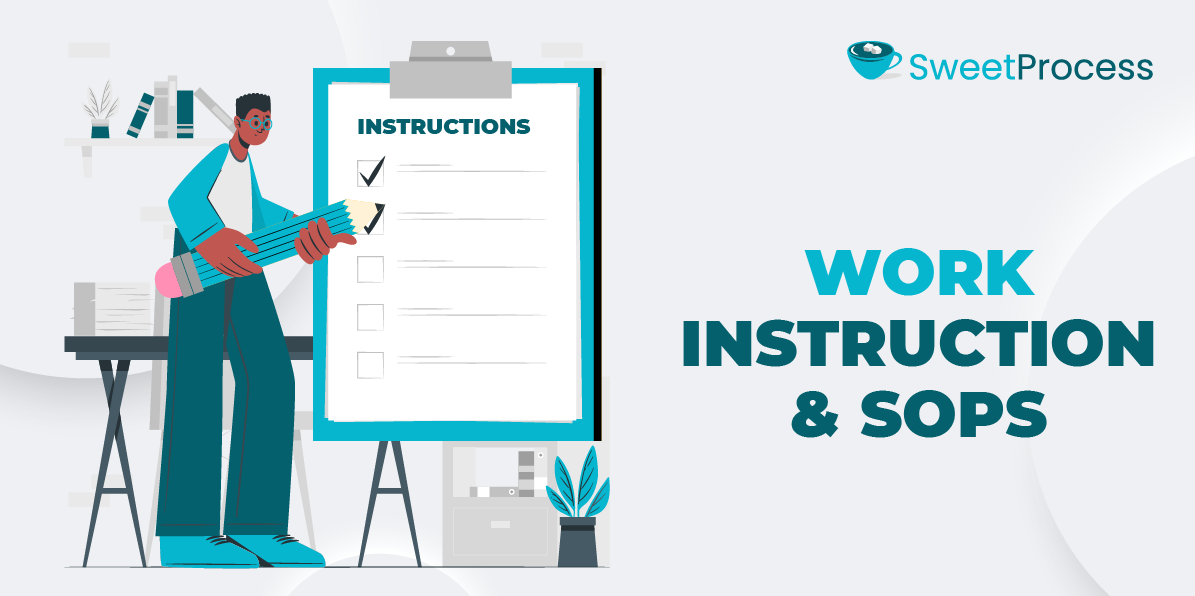
Work instructions focus on the specifics. They’re super-detailed, step-by-step guides that show exactly how to perform a particular task, especially if it’s technical or complex.
If standard work covers the whole process, work instructions zoom in on one part and clarify it.
Standard operating procedures (SOPs), on the other hand, offer a bigger-picture approach. They focus on the rules and general guidelines for handling operations or situations.
SOPs are not as detailed as work instructions but provide enough direction to ensure teams stay on the same page.
8-Step Processes
The 8-step process offers a structured approach to problem-solving and continuous improvement. It creates a clear roadmap for identifying issues, finding solutions, and making sustainable changes.
Originally popularized in lean and Six Sigma practices, this method ensures that teams systematically address problems rather than relying on quick fixes.
A Short Breakdown
1. Define the Problem: Identify what’s wrong and why it’s a problem.
2. Break Down the Problem: Analyze the issue in smaller parts to understand its root cause.
3. Set a Goal: Establish a clear and measurable target for your goal.
4. Analyze the Root Cause: Use tools like the 5 Whys or fishbone diagram to find the underlying cause.
5. Create Solutions: Identify and rank practical actions to tackle the underlying issue.
6. Implement Solutions: Implement your chosen countermeasures and monitor their effectiveness.
7. Evaluate Results: Check if the solutions solved the problem and met your goals.
8. Standardize the Process: Incorporate the successful solution into work standard to prevent the issue from happening again.
Videos

Instead of relying on long, text-heavy documents, videos demonstrate exactly how tasks should be done step-by-step.
This visual approach simplifies employee understanding and facilitates process adherence, especially for complex or hands-on tasks.
Watching the task performed in real time enables employees to catch details they might miss in written instructions.
Videos also offer flexibility. New hires can watch and rewatch training videos at their own pace, which accelerates the onboarding process.
Would you rather watch a tutorial (complex task) or read a technical article?
Many might go for the article, but we bet the majority go for the video guide.
One-Point Lesson
A one-point lesson (OPL) delivers a simple, quick way to teach a specific skill or explain a concept.
OPLs are designed to be easy to understand, using minimal text and often including visuals like photos, diagrams, or charts.
For example, an OPL might walk someone through a step-by-step guide on assembling a piece of equipment or troubleshooting a problem.
These OPLs are especially useful in fast-paced work environments where teams need to learn something quickly or make minor improvements.
Since they’re short and straightforward, OPLs ensure employees retain information without overwhelming them with too many “important” details.
Twi Job Instruction
Training within industry (TWI) job instruction (JI) teaches employees how to do their jobs safely, efficiently, and correctly.
The TWI process comes in four easy steps:
1. Prepare the Worker: Before jumping into the specific task, you want to ensure the worker feels comfortable and ready to learn.
This is about explaining the job, getting to know what they already understand, and setting the stage for a smooth learning experience.
2. Present the Job: Now, you break the task down into small, manageable steps and show the worker how to perform each step.
While demonstrating, you explain why it’s done that way so they understand the reasoning behind the steps. Just to make sure they get it, go over it a few times.
3. Try out the Job: Next, it’s the worker’s turn to try it out for themselves. They’ll perform the task with guidance and feedback from you.
4. Follow-Up: After the training, regular check-ins are key. This way, you verify if they’ve retained the skills and are still performing the task correctly.
What Should Be Standardized?

Not everything needs to be standardized, but some key areas in any organization greatly benefit from it:
Core Processes
Routine tasks, like manufacturing steps or customer onboarding, should follow a standard process similar to lean manufacturing. For example, standardizing the checkout process in a retail setting ensures every customer experiences a smooth, consistent interaction.
Safety Procedures
Safety should always be top of mind. Simplifying safety protocols—like how to operate equipment or handle emergencies—minimizes risks and keeps everyone on the same page.
Quality Control
To keep product or service quality high, it’s crucial to standardize things like inspection processes or customer service responses. The result is that the outcome is consistently up to standard no matter who handles the task.
Onboarding and Training
Standardizing these processes quickly equips new employees with essential knowledge and maintains consistency in training.
Customer Service

Whether handling complaints or answering questions, standardized procedures for customer service create a consistent experience and prevent errors or omissions.
Technology and Tools
Standardizing software tools and systems within the company streamlines communication and collaboration, making everyone’s job easier.
What Should Not Be Standardized?
As much as standardization benefits many parts of an organization, we must acknowledge its limits. Certain areas demand flexibility and creativity to thrive:
Creative Processes
Creativity thrives on freedom. In marketing or design, standardized processes could stifle innovation.
Allowing your team to experiment with different ideas, approaches, and strategies leads to fresh, creative solutions that wouldn’t emerge in a rigid system.
Think about how ad campaigns or product designs often need to push boundaries—standardization would limit that creative flow.
Problem-Solving and Decision-Making
Every situation is unique, and while processes for problem-solving guide teams, they shouldn’t be standardized to the point where they restrict critical thinking.
Employee Autonomy
Employees need the freedom to manage their work and make decisions that best fit their role or situation.
Over-standardizing how tasks are performed or micromanaging day-to-day activities leads to frustration and a lack of ownership.
Allowing employees to take the initiative encourages growth, responsibility, and better performance.
Leadership Styles
Different situations call for different leadership approaches. A manager who leads a creative team might need to take a more hands-off, empowering approach while managing a production team might require a more directive style.
Implementing rigid leadership methods across the board results in ineffective management that doesn’t meet the unique needs of different teams.
Employee Development
Each employee is different and may require a personalized development plan. Streamlining coaching or training doesn’t account for individual strengths, weaknesses, and career goals. A more flexible approach promotes tailored growth, not a one-size-fits-all employee development plan.
Customer Interactions (in Certain Contexts)
While it’s important to have consistent standards for some customer interactions, others require a personalized touch.
For instance, a customer might have a unique issue that doesn’t fit neatly into a script. Standardizing responses for every possible issue leads to robotic and ineffective interactions. Take our word for it: Customers want human connection, not a mechanical FAQ program.
Common Standard Work Examples
Safety Measures
Safety isn’t just a checklist; it’s a mindset.
As Jeff Cooper, a former United States Marine and renowned firearms instructor, aptly said: “Safety is something that happens between your ears, not something you hold in your hands.” aptly said: “Safety is something that happens between your ears, not something you hold in your hands.”
This means safety is primarily about mindset and awareness rather than relying solely on tools or equipment. A worker wearing protective gear but not following safety procedures due to negligence or lack of training puts them at risk.
Regulating safety measures ensures everyone in the organization knows how to respond, whether it’s handling equipment, conducting emergency drills, or performing worksite safety inspections. It’s about creating a culture where proactive thinking prevents reactive regret.
Training and Onboarding

A new hire walks into their first day (Monday) eager to impress, only to find out their manager forgot they were starting.
No desk, no training materials, and their computer password? Still stuck in IT limbo.
By the end of the week, they’ve spent more time wandering the office than learning their role—and their enthusiasm is already on the decline.
By Friday, they’re trash posting about the company’s work ethics with an anonymous account on X.
An obvious solution? A clear and structured onboarding process. It sets new employees up for success by helping them understand the company culture, responsibilities, and how to thrive in their roles.
Quality Checks
Imagine you’re dining at a restaurant that promises the best pasta in town. The first time, the pasta is perfectly al dente with just the right amount of sauce.
The next time? It’s a soggy mess drowning in marinara. What changed? Likely a lack of standardized quality checks.
When businesses establish consistent quality control processes, they ensure that every dish or product meets the same high standard every time.
Machinery or Technology
When it comes to machinery or technology, standard work examples often involve tasks like operating equipment, navigating software, or handling routine maintenance.
These processes benefit from clear standard work instructions, ensuring tasks are completed safely and efficiently while maintaining consistency.
Worker-Supervisor Communication
Is there a mysterious cut in the marketing budget that nobody signed off on but everyone’s whispering about?
Or a last-minute change to the project deadline no one warned you about?
Clear and structured communication between workers and supervisors puts an end to these office mysteries.
Everyone’s on the same page. There’s a surge in productivity, and there are no surprises.
Customer Service Interaction
By now, this should feel pretty familiar, and that’s because it’s crucial to maintaining trust and clear communication with your customers.
A clear approach helps your team respond to questions quickly, solve problems efficiently, and leave customers with a positive experience.
From tone of voice to problem-solving techniques, a structured method empowers teams to meet customer expectations while staying consistent across channels.
Design Process
Creating something exceptional doesn’t happen by chance—it results from a thoughtful, organized design process.
Following a clear workflow makes this possible. Teams can move smoothly from brainstorming ideas to final execution.
Work Location
Where and how we work shapes productivity and collaboration. Setting standards for work locations—whether in an office, remote, or hybrid setup—aligns expectations for communication, accessibility, and focus.
Who Benefits from Standardized Work?
Employees
Let’s be honest. As an employee, work sucks a little less when you know exactly what you’re doing. Sticking to set procedures means fewer screw-ups, fewer awkward “Oops” moments with the boss or team lead, and less stress. It was created to assist employees in taking charge of their tasks, streamlining, and improving workflows.
Supervisors and Managers
As a supervisor, rolling out standardized work processes turns back the clock and keeps the gray hairs at bay.
Imagine walking into a shift where everyone knows exactly what they’re supposed to do, and you don’t have to dodge Carl, the new employee, waiting by your office with a notepad full of questions.
It’s a game-changer. Less micromanaging, fewer “What do I do next?” questions and more time to focus on the stuff that actually moves the needle.
Executives
When an organization gets its processes in order, it’s like hitting the refresh button.
You stop wasting time and work faster, and suddenly, resources that would’ve been lost are available for better use.
The bottom line is it boosts morale, strengthens communication, and creates a safer environment for employees.
It’s a win-win for executives: increased productivity, less chaos, and the chance to allocate funds to new opportunities.
Customers
When companies run like well-oiled machines, everyone benefits. Standards aren’t just rules—they’re the blueprint for success.
They ensure that products are top-notch and consistent in quality, orders are delivered quickly, and customer service is seamless.
The result? Happy customers who trust the brand and keep coming back for more.
And you can build that loyalty with SweetProcess! Use it to create consistent workflows, ensure top-notch results, and keep your customers returning for more.
Is Standard Work Bad?
Some people think standard work is too rigid, leaving little room for creativity, or that it turns team members into robots.
But that’s only part of the story. Standard work is all about setting up clear and consistent processes so work gets done efficiently and with fewer mistakes.
When the repetitive stuff runs smoothly, your team has more time to focus on solving bigger problems or coming up with fresh ideas. You’re giving them a solid foundation to build on instead of starting from scratch every time.
Of course, it backfires if handled poorly. Making it too strict or ignoring feedback might frustrate employees. But getting it right keeps things organized while still leaving room for flexibility and improvement.
It’s a tool to help, not a rulebook to control.
Enhance Your Company’s Standard Work Documentation Using SweetProcess
Documenting standard work doesn’t have to be complicated. SweetProcess allows you to easily create, organize, and share your standard work documentation with your team.
SweetProcess offers a user-friendly platform that streamlines and automates your workflows, ensuring all employees can access the latest and most effective procedures.
Don’t let valuable knowledge and processes slip through the cracks due to the lack of a knowledge management system. Start documenting and sharing your standard work with SweetProcess today.
Sign up for a 14-day free trial and experience how easy it is to enhance your company’s efficiency, consistency, and communication.

